Democratic Voters Are Most Likely to Be Found Where?
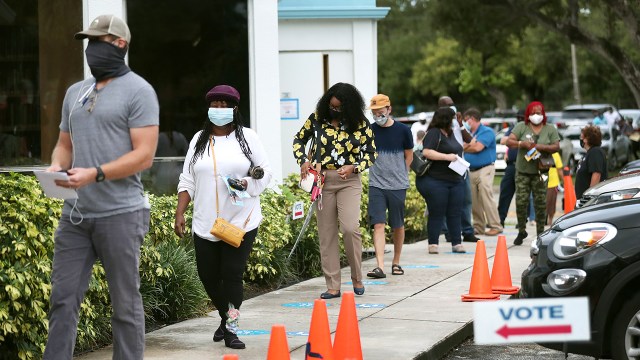
The United States holds a presidential election every four years, but it's not just the candidates and issues that change from one campaign cycle to the next. The electorate itself is in a slow but constant state of flux, too.
The profile of the U.S. electorate pot modification for a diversity of reasons. Consider the millions of Americans who give upturned 18 and can vote for president for the first prison term this year, the immigrants who take over become naturalized citizens and can regurgitate ballots of their own, operating theatre the longer-term shifts in the rural area's biracial and ethnic makeup. These and other factors ascertain that no two presidential electorates smel exactly the one.
So what does the 2020 electorate look like politically, demographically and scrupulously as the race between Republican President Donald Trump and Democrat Joe Biden enters its final days? To answer that question, present's a roundup of recent Church bench Research Center findings. Unless otherwise noted, all findings are supported registered voters.
Political party identification
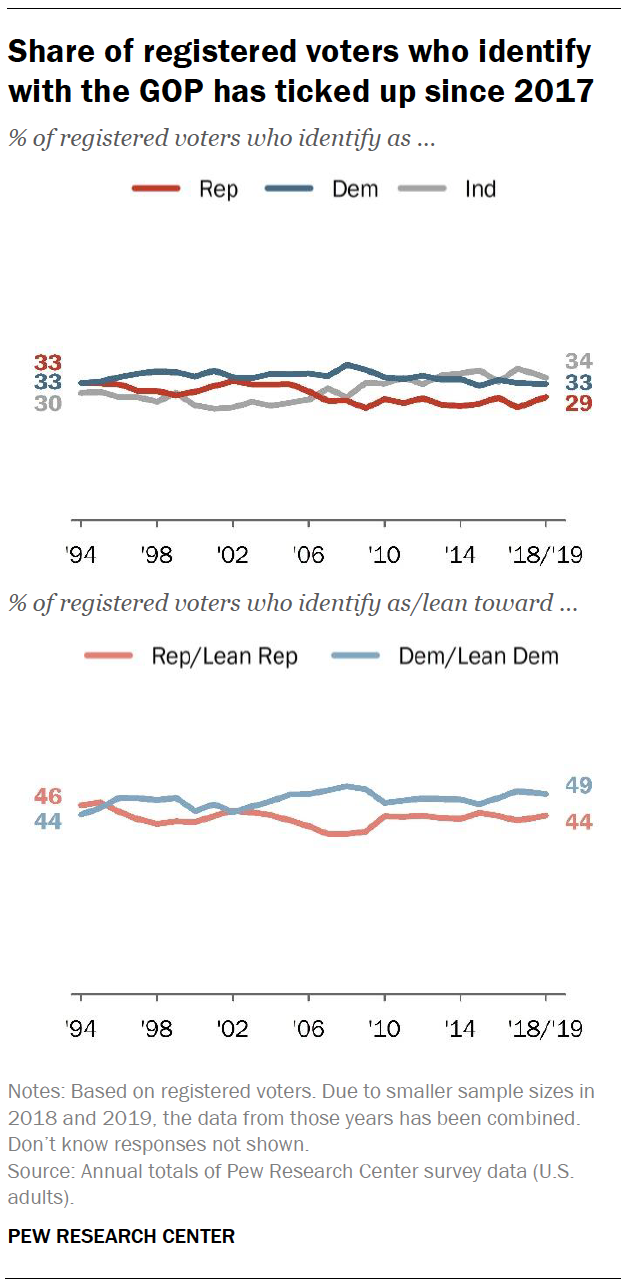
Roughly a third of registered voters in the U.S. (34%) identify Eastern Samoa independents, while 33% identify equally Democrats and 29% identify as Republicans, accordant to a Essence depth psychology of Americans' partisan identification based on surveys of more than 12,000 registered voters in 2018 and 2019.
Most independents in the U.S. lean toward one of the two prima parties. When taking independents' partisan leanings into account, 49% of all registered voters either identify American Samoa Democrats or lean to the party, while 44% identify as Republicans operating theater slender to the GOP.
Party recognition among certified voters hasn't changed dramatically finished the past 25 years, but there have got been some lowly shifts. One so much transformation is that the Democratic Party's advantage over the Republican Party in party identification has get along little since 2017. Of course, just because a registered voter identifies with operating theatre leans toward a particular party does not inevitably mean they will voting for a candidate of that party (or voter turnout at all). In a study of valid voters in 2016, 5% of Democrats and Democratic leaners according voting for Trump, and 4% of Republicans and Republican Party leaners according vote for Sir Edmund Percival Hillary Bill Clinton.
Race and ethnicity
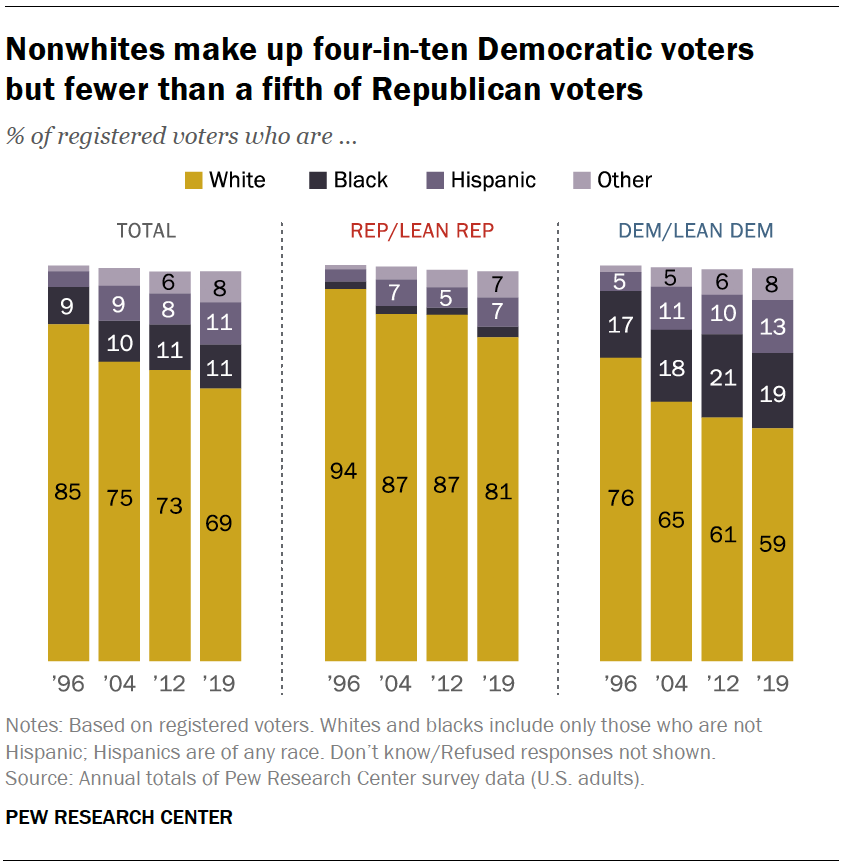
Non-Hispanic White Americans make up the largest share of registered voters in the U.S., at 69% of the total as of 2019. Hispanic and Black listed voters each account for 11% of the add together, piece those from other racial or ethnic backgrounds account for the residue (8%).
White voters explanation for a lessened share of registered voters than in the past, declining from 85% in 1996 to 69% ahead of this class's election. This change has unfolded in some parties, but White voters have consistently accounted for a much larger share of Party and Republican-propensity registered voters than of Elective and Democratic-leaning voters (81% vs. 59% A of 2019).
The racial and irreligious composition of the electorate looks very divers nationally than in several key battleground states, according to a Center analysis of 2018 data supported entitled voters – that is, U.S. citizens ages 18 and older, unheeding of whether or not they were enrolled to balloting.
White Americans accounted for 67% of bailable voters nationally in 2018, but they represented a much larger share in different key battlegrounds in the Midwest and Mid-Ocean, including Wisconsin (86%), Ohio (82%), Pennsylvania (81%) and Michigan (79%). The reverse was true in some battleground states in the West and South-central. For instance, the White share of suitable voters was down the stairs the national ordinary in Nevada (58%), Florida (61%) and Arizona (63%). You lav go through interracial and heathen breakdown of eligible voters in whol 50 states – and how it changed between 2000 and 2018 – with this interactive feature.
Age and generation
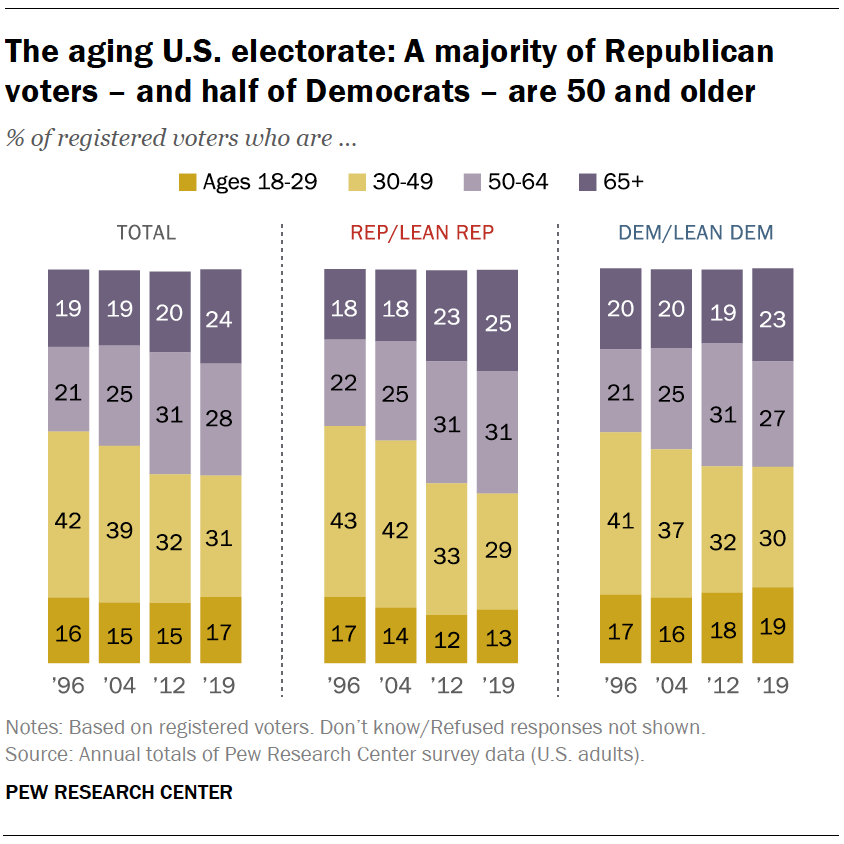
The U.S. electorate is aging: 52% of registered voters are ages 50 and older, up from 41% in 1996. This shift has occurred in both denominational coalitions. To a higher degree half of Republican and GOP-lean voters (56%) are ages 50 and older, up from 39% in 1996. And among Democratic and Democratic-leaning voters, half are 50 and older, up from 41% in 1996.
Another way to consider the aging of the electorate is to looking at median get on. The median mature among all registered voters inflated from 44 in 1996 to 50 in 2019. IT rose from 43 to 52 among Republican enrolled voters and from 45 to 49 among Democratic certified voters.
Despite the long-term aging of listed voters, 2020 marks the first prison term that many members of Propagation Z – Americans born after 1996 – will be able to participate in a presidential election. One-in-ten worthy voters this year are members of Genesis Z, up from just 4% in 2016, according to Church bench Research facility projections. (Of course of action, not all eligible voters wind up registering and actually casting a ballot.)
Education
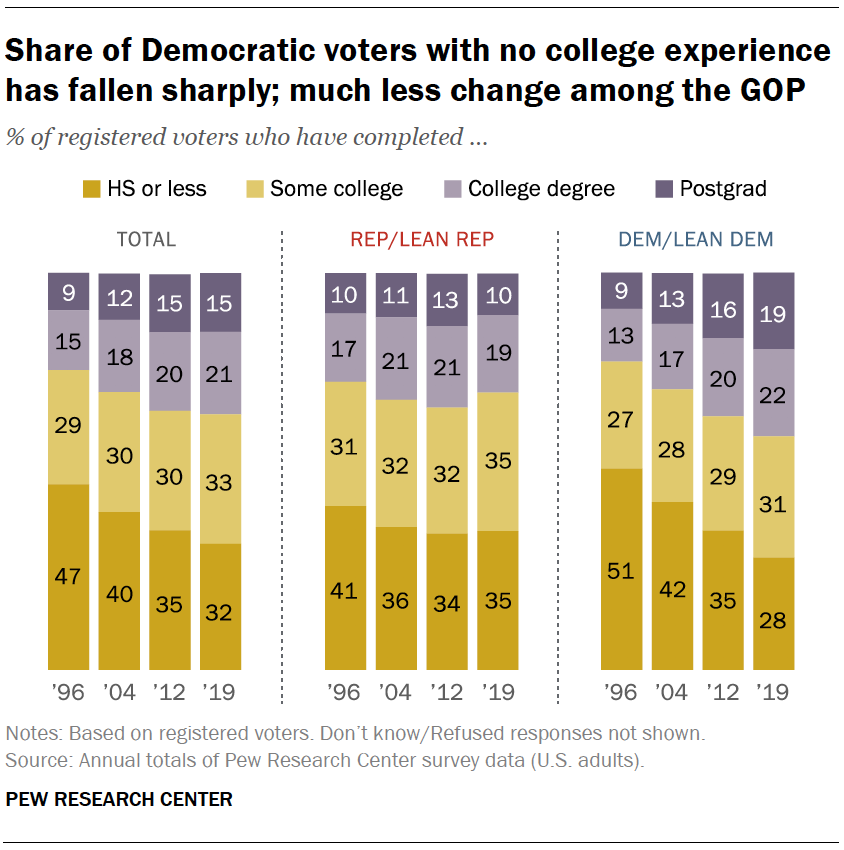
Around deuce-thirds of registered voters in the U.S. (65%) do not have a college degree, piece 36% do. But the parcel of voters with a college degree has risen well since 1996, when 24% had incomparable.
Voters who place with the Democratic Party or lean toward it are much more likely than their Party counterparts to ingest a college degree (41% vs. 30%). In 1996, the turnabout was true: 27% of GOP voters had a college degree, compared with 22% of Classless voters.
Religion
Christians account for the majority of registered voters in the U.S. (64%). But this figure is down from 79% as latterly as 2008. The share of voters who identify as sacredly independent has all but double during that span, from 15% to 28%.
The partake of White Christians in the electorate, particularly, has decreased in recent years. White evangelical Protestants chronicle for 18% of registered voters today, down from 21% in 2008. During the same period, the ploughshare of voters WHO are White non-evangelical Protestants fell from 19% to 13%, while the share of White Catholics fell from 17% to 12%.
Around eight-in-ten Republican registered voters (79%) are Christians, compared with nigh half (52%) of Democratic voters. In deform, Democratic voters are much more likely than GOP voters to identify as conscientiously unaffiliated (38% vs. 15%).
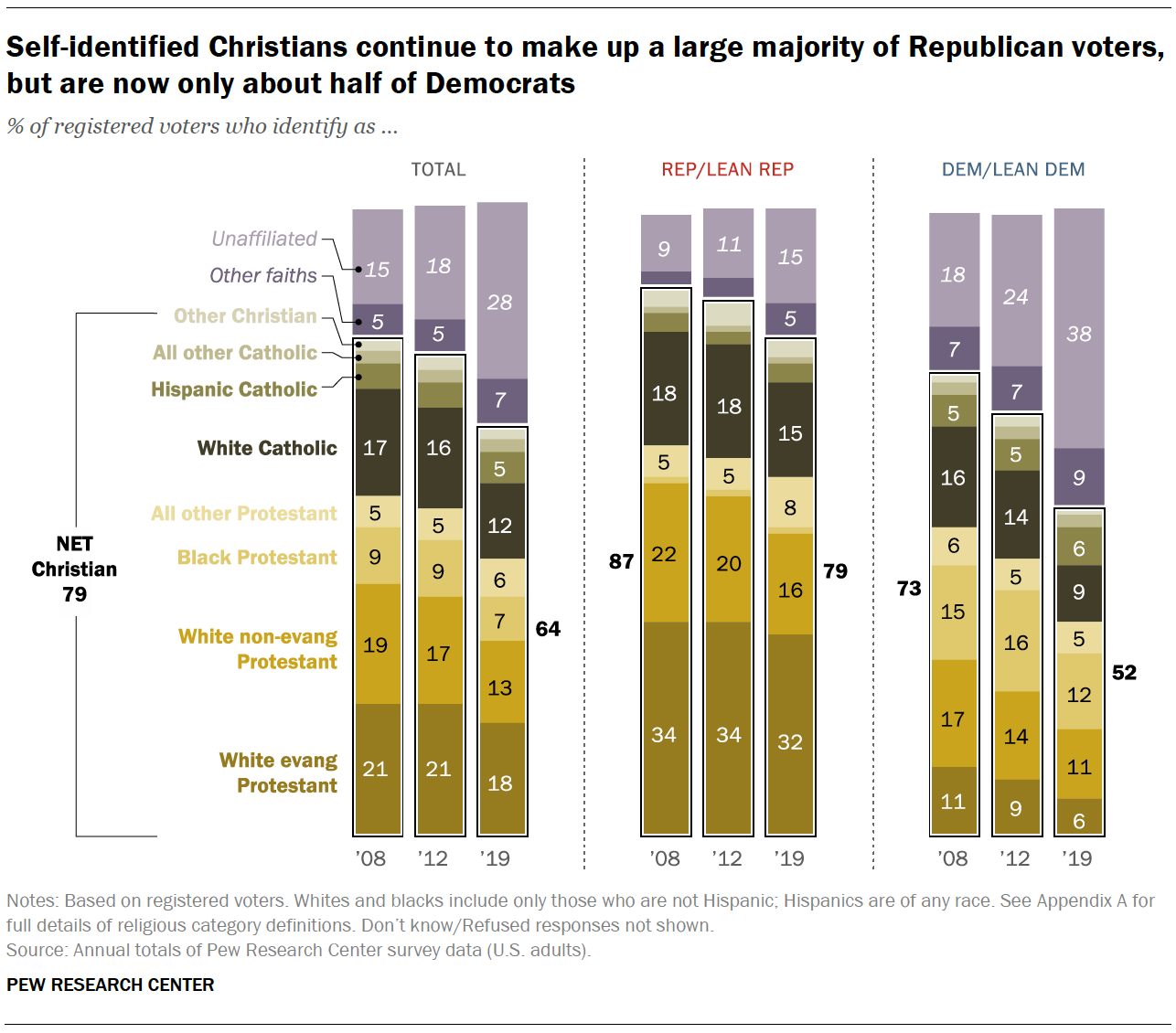
The key question: What about vote?
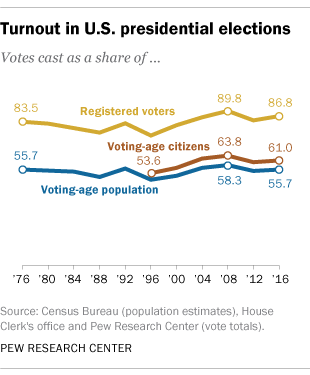
Surveys can provide reliable estimates about registered voters in the U.S. and how their partisan, demographic and religious profile has changed over time. But the critical question of voter turnout – World Health Organization will follow motivated to cast a ballot and who will not – is more than difficult to suffice.
For ane thing, not all enrolled voters end up voting. In 2016, around 87% of registered voters cast a ballot, accordant to a Pew Research facility analysis of Bureau of the Census data shortly after that yr's election.
Also, voter turnout in the U.S. is not a constant: IT can and does change from unmatched election to the next. The divvy up of certified voters who cast a ballot was higher in 2008 than four eld ago, for example.
Railroad siding besides varies by demographic factors, including race and ethnicity, age and gender. The turnout rate among Black Americans, for instance, exceeded the rate among White Americans for the first time in the 2012 statesmanly election, simply that approach pattern did non defend four age later.
Thusly what does all this mean for 2020? There are some early indications that overall turnout could reaching a record high this yr, even as turnout in the midterms two years ago reached its highest point in a century. Merely 2020 is faraway from an ordinary year. The combination of a global pandemic and public concerns nigh the integrity of the election ingest created widespread uncertainty, and that uncertainty makes it even more difficult than familiar to assess who leave vote out and who won't.
Democratic Voters Are Most Likely to Be Found Where?
Source: https://www.pewresearch.org/fact-tank/2020/10/26/what-the-2020-electorate-looks-like-by-party-race-and-ethnicity-age-education-and-religion/
0 Response to "Democratic Voters Are Most Likely to Be Found Where?"
Post a Comment